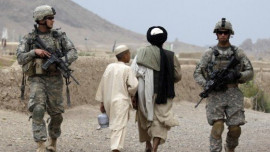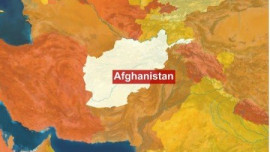
In the harsh desert heat on the northern border with Uzbekistan, workers are hammering down the tracks of Afghanistan’s first railway, being built with a grant of 165 million dollars from the Asian Development Bank (ADB).
The first section of 75 kilometres will link the northern Afghan city of Mazar-i-Sharif to the Uzbek border, where the Friendship Bridge crosses the Amu River into the vast expanses of the former Soviet states and beyond.
The line, being built by Uzbekistan’s state-owned rail corporation, is due to be completed in September, the first section of a network that officials hope will facilitate trade and link Afghanistan to international seaports.
“This is a historic day, it’s the beginning of a vital project for Afghanistan and the region,” Finance Minister Omar Zakhailwal told officials and diplomats at an inauguration ceremony last week.
“This railroad will spark an economic revolution not only in Afghanistan but across the region,” he said, after flying into the border town of Hairatan by helicopter.
The project aims to open up the agricultural, textile and mineral wealth of Afghanistan to export markets from Asia to Europe.
“I think it’s a very, very important project,” said Sayed Masoud, an economist at Kabul University.
“It gains us credibility among our neighbours and makes our country a stable transit hub in the regional trade between Pakistan and the Central Asian countries and China,” he told AFP.
Future plans to open up the country with rail include a line from Mazar-i-Sharif to Herat, the eastern city close to the border with Iran, to connect with a track being built from the other side.
Mazar-i-Sharif was once an important caravan stop on the ancient “silk road” which connected China to the world.
But a series of wars and the thwarting of British imperial overtures saw Afghanistan – long at the vortex of geopolitical games – miss out on the railway boom that colonisers brought to its neighbours.
The country of mountains, valleys and deserts lacks basic infrastructure, with just one ring road linking major cities but offering an often-treacherous drive through teetering passes and territory controlled by the Taliban.
The north has been largely sheltered from the insurgency, though in recent years the Taliban have made inroads as they have targeted the road routes for Nato supplies coming from Tajikistan.
This could make the railway project vulnerable to militant attack. The international community wants to speed up the end of the war with an influx of soldiers taking the fight to the Taliban in their southern fiefdom in Kandahar province, with hopes the threat will be quelled later this year.
In tandem with these plans are efforts to build up Afghanistan’s security forces and pour money into rebuilding the country from the ground up.
Experts say the railway is integral to Afghanistan’s ability to stand alone.
Hairatan is showing the way forward, having in recent years become a lively centre for trade with more than half the country’s imports – mostly fuel, food and construction materials – coming in through Uzbekistan.
“The tangible benefits of the new rail link are tremendous,” said Haruhiko Kuroda, ADB president.
“The line will help reduce trade bottlenecks, boost commerce and speed the flow of much-needed humanitarian assistance.”
Published in the Express Tribune, May 31st, 2010.




































1713853507-0/MalalaHilary-(2)1713853507-0-270x192.webp)








COMMENTS
Comments are moderated and generally will be posted if they are on-topic and not abusive.
For more information, please see our Comments FAQ